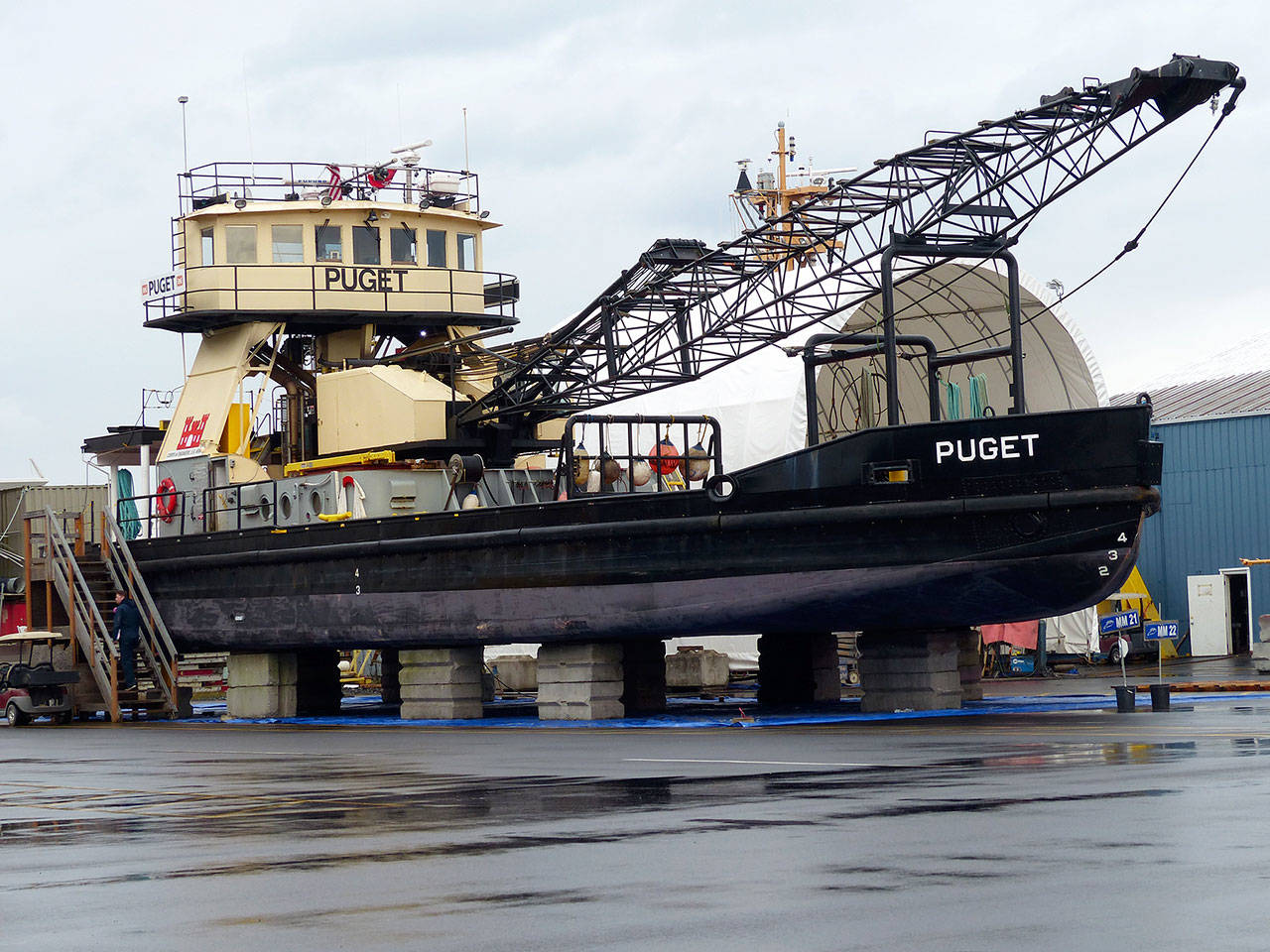WEDNESDAY, THE USAV Palo Alto moored to the visitors dock on the west side of the harbormasters office at the Port Angeles marina. She is a 174-foot long landing craft with a bow ramp and a 420-foot beam that is capable of carrying 350 tons of cargo.
As many as 12 personnel serve on the vessel, although I understand she can operate with as few as five crew members. USAV Palo Alto is assigned to the 481st Transportation Company in Mare Island, Calif.
As to why the boat was so far from its home base I couldn’t say, although I was told they stopped in Port Angeles to give the crew an opportunity to spend a few hours off the boat.
Platypus Marine, the full-service shipyard, yacht-repair facility and steel-boat manufacturer on Marine Drive in Port Angeles has the MV Puget sitting on the hard. Personnel will inspect and maintain and service as needed the sea chest, prop and rudder system.
Puget is a 104-foot, flat-bottom steel vessel with a 30-foot beam that is operated by the U.S. Army Corps of Engineers.
The Puget is the debris recovery vessel used by the Corps. throughout the Puget Sound region to remove wrecks and obstructions in rivers and harbors, and any objects deemed to be obstructions to navigation.
They may also remove trees, brush and other debris that may cause flooding. The vessel is used to remove and dispose of sunken vessels, waterfront debris, derelict structures and other sources of drift that may damage vessels or threaten public health, recreation or the environment at publicly maintained commercial boat harbors.
The Puget has a five-person crew and is based out of the Hiram M. Chittenden locks in Ballard, Washington.
Platypus has Surfbird in the Commander building. She is a 115-foot B&B Boat Builders Yacht. Personnel are fabricating and installing stabilizers and painting the wheelhouse and the mast.
Forever, an 80-foot Hakvoort, is also in the Commander building, receiving interior upgrades, new windows and a fresh coat of paint.
Reel Adventure is also in the large blue Commander building on Marine Drive. She is a Sea Ranger 56 that had her swim step resurfaced and new windows installed.
Demolition
The Port of Port Angeles recently obtained a demolition permit to tear down the former Jig and Lure Restaurant on Boathaven Drive. The task is scheduled to be completed by the end of the month.
Future plans for the site include the construction of a laundromat which is scheduled to be in operation this summer.
I stopped by the Port Angeles Boat Yard this week and saw that Fred Rodolf had Lu-Lu Belle out of the water for her annual maintenance. Capt. Fred takes meticulous care of his boat. He designed and built this boat himself.
Capt. Fred began construction in November of 1976 when he purchased a Kelly Hull from Westport. The project was completed within 10 months and in September of 1977 Lu-Lu Belle was certified by the United States Coast Guard.
The plush 75-foot touring vessel operates out of Valdez, Alaska, and has been taking tours to the Columbia Glacier and making wildlife cruises for over 25 years.
Tall ships to visit in June
I received a phone call Friday morning and was told that the tall ships Lady Washington and Hawaiian Chieftain are coming to Port Angeles, June 8 to June 10.
Tesoro Petroleum started out the week by providing bunkers to Peterborough, a 616-foot Liberian flagged bulk cargo ship and Cabo Misaki, a 748-foot Panamanian flagged crude oil tanker.
Refueling question
Wednesday, Tesoro refueled Cartagena, a 600-foot petroleum products carrier that is flagged in Libya
I’ve received a number of calls recently asking why oil tankers anchor in the harbor and refuel as often as they do.
Many of us correctly perceive that the tankers would have enough fuel storage capacity to make a number of trips to and from the Alaskan oil fields and their respective refineries between refuelings.
I asked the folks at Tesoro Petroleum on Ediz Hook and was told that because of the Magnuson Act of 1977, which restricted the weight capacity of crude oil tankers in Puget Sound, it is a matter of economics.
The cost of frequent refueling is less than the profit gained by carrying additional bulk oil. Therefore, the less refined fuel oil a tanker carries for its own consumption, the more crude oil cargo it can carry.
_________
David G. Sellars is a Port Angeles resident and former Navy boatswain’s mate who enjoys boats and strolling the area’s waterfronts and boat yards.
Items and questions involving boating, marina and industrial activities and the North Olympic Peninsula waterfronts are always welcome. News announcements about boating groups, including yacht clubs and squadrons, are welcome as well.
Email dgsellars@hotmail.com or phone him at 360-808-3202.
